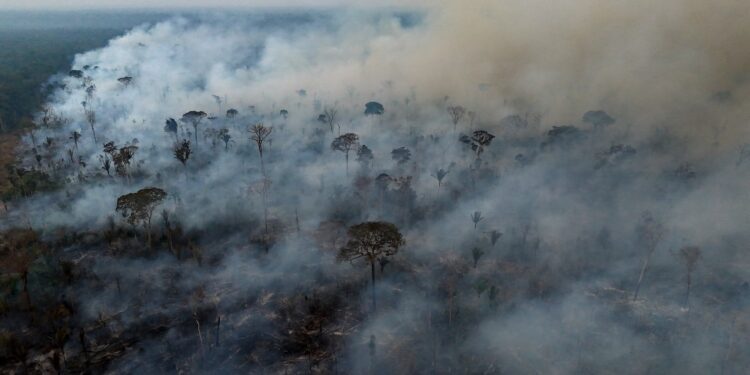South America is experiencing its worst forest fire season in nearly two decades, with millions of acres burning across several countries. The blazes come amid the region’s worst drought on record, and are no surprise to climate scientists who have seen this coming for decades.
Satellite data analyzed by Brazil’s space research agency Inpe identified a record-breaking 346,112 fire hotspots so far this year in the 13 countries of South America. All that smoke is so thoroughly choking large swaths of the continent that NASA satellites captured the plumes from 1 million miles away.
In Brazil, the continent’s largest country, about 59 percent of the country is facing drought conditions — an area roughly half the size of the United States — and Amazon basin rivers are flowing at historic lows. Three of the six vast ecosystems that define the country — the Amazon, the Cerrado and the Pantanal wetlands — are parched and burning.
“We are facing one of the worst droughts in history,” said Ane Alencar, director of science at the Amazon Environmental Research Institute. The fires, she said, are the most extreme since 2005 and will continue until the rains come, which is typically in October but are no longer a guarantee. “We don’t know if rain is going to come.”
The proximate causes of the ongoing carnage are intentional fires that escape into the forest, and the naturally occurring El Nino weather pattern that is creating dry conditions. But experts say the compounding effects of climate change are making the crisis far worse, and the consequences are in line with what scientists have been warning could become the norm.Â
“This is exactly what all the climate models have been predicting for 20 years or more,” said Steve Schwartzman, senior director of forest policy at the Environmental Defense Fund. Erika De Berenguer Cesar, a tropical forest ecologist at Lancaster University in the United Kingdom, worries that, absent dramatic action, people could one day look back at 2024 as a typical year. “It’s going to get much, much worse.”
Scientists say that a warming planet is already more of a factor than El Nino in the ongoing drought. And, according to the latest report from the Intergovernmental Panel on Climate Change, seasonal droughts in the region “are projected to lengthen by 12 to 30 percent, intensify by 17 to 42 percent, and increase in frequency by 21 to 42 percent” by the end of the century.
Drier weather means drier forests and when ranchers or farmers set fires to clear land, a higher likelihood that they will lose control of them. While Alencar notes that Indigenous communities have used small-scale fires to manage land for centuries, the forest was humid enough to keep them largely contained. Climate change has altered that reality, she said, making it so that “any fire activity caused by humans can actually have a huge impact.”
Deforestation is now a major driver of forest fires, particularly in the Amazon. Not only does clearing the land create more opportunities for fire to spread, but losing the Amazon, which stretches across 2.5 million square miles, means losing a critical carbon sink for planet-warming emissions. That further deepens the climatic changes that are exacerbating fire risks.
“It seems to me that things are getting worse, year after year after year,” Brazilian President Luiz Inácio Lula da Silva said on a recent trip to the drought-ridden state of Amazonas, where all 62 municipalities have declared a state of emergency. More than 340,000 people have reportedly been affected.
Lula’s government took office in 2023 on a pledge to crack down on illicit deforestation of the Amazon, which reached unprecedented heights under his predecessor Jair Bolsonaro. Although deforestation has plummeted dramatically, the rainforest continues dwindling as people continue to set fires that spread.Â
This largely human-induced providence is one way that the Amazonian conflagrations differ from those raging in other parts of the world, such as the American West. Another distinction is the biological scale of what’s at stake: The Amazon is home to 10 percent of the world’s biodiversity and one-fifth of its fresh water, and it was never meant to burn.
“They’ve never burned, they’ve never coexisted with the fire,” Guillermo Villalobos, a political scientist focusing on climate science at Bolivian nonprofit Fundación Solon, told ABC News. “This is terribly tragic for the ecosystem and the world.”
Source link : http://www.bing.com/news/apiclick.aspx?ref=FexRss&aid=&tid=66e491ec50694b6eb06c5f11fcb0afca&url=https%3A%2F%2Fgrist.org%2Fwildfires%2Fno-one-should-be-surprised-that-south-america-is-burning%2F&c=10244100385915635756&mkt=en-us
Author :
Publish date : 2024-09-13 07:32:00
Copyright for syndicated content belongs to the linked Source.












